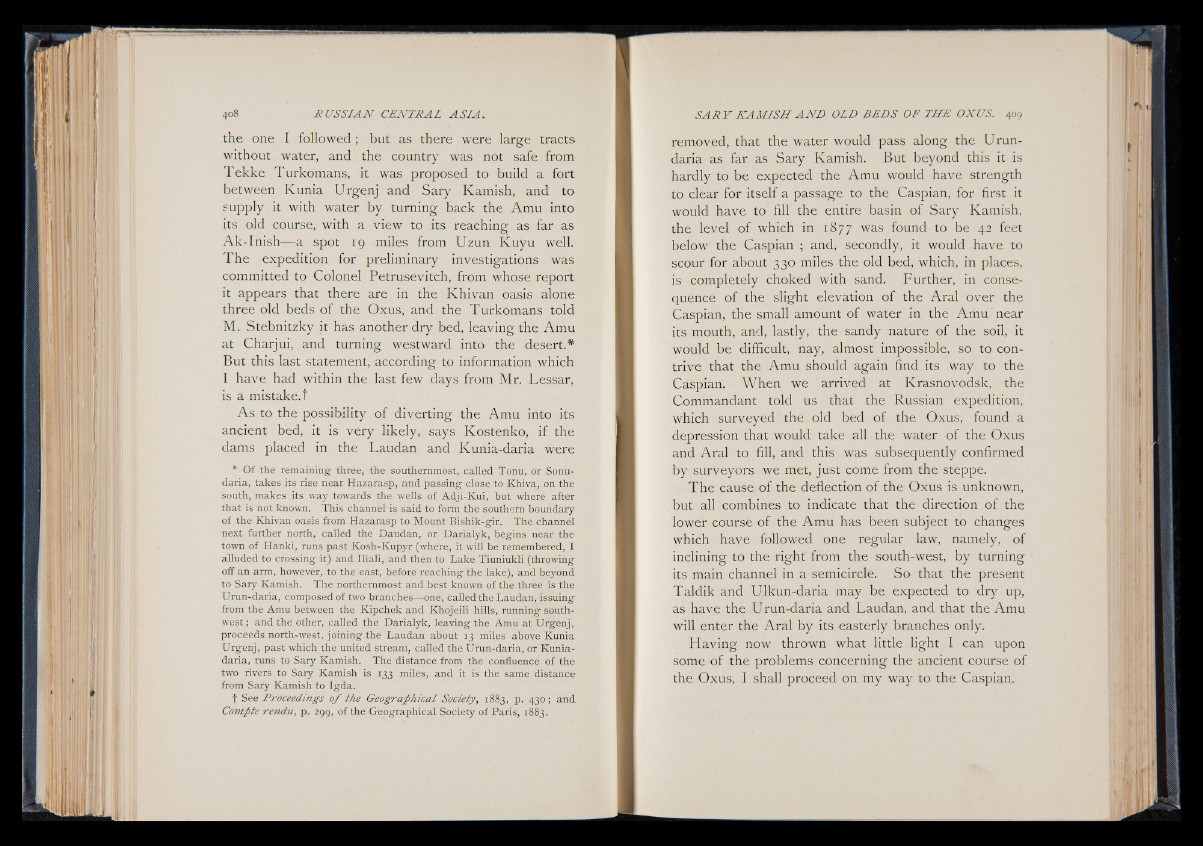
the one I followed; but as there were large tracts
without water, and the country was not safe from
Tek ke Turkomans, it was proposed to build a fort
between Kunia Urgenj and Sary Kamish, and to
supply it with water by turning back the Amu into
its old course, with a view to its reaching as far as
Ak-Inish— a spot 19 miles from Uzun Kuyu well.
The expedition for preliminary investigations was
committed to Colonel Petrusevitch, from whose report
it appears that there are in the Khivan oasis alone
three old beds of the Oxus, and the Turkomans told
M. Stebnitzky it has another dry bed, leaving the Amu
at Charjui, and turning westward into the desert.*
But this last statement, according to information which
I have had within the last few days from Mr. Lessar,
is a mistake, t
A s to the possibility of diverting the Amu into its
ancient bed, it is very likely, says Kostenko, if the
dams placed in the Laudan and Kunia-daria were
* Of the remaining three, the southernmost, called Tonu, or Sonu-
daria, takes its rise near Hazarasp, and passing close to Khiva, on the
south, makes its way towards the wells of Adji-Kui, but where after
that is not known. This channel is said to form the southern boundary
of the Khivan oasis from Hazarasp to Mount Bishik-gir. The channel
next further north, called the Daudan, or Darialyk, begins near the
town of Hanki, runs past Kosh-Kupyr (where, it will be remembered, I
alluded to crossing it) and Iliali, and then to Lake Tiuniukli (throwing
off an arm, however, to the east, before reaching the lake), and beyond
to Sary Kamish. The northernmost and best known of the three is the
Urun-daria, composed of two branches— one, called the Laudan, issuing
from the Amu between the Kipchek and Khojeili hills, running south-'
west; and the other, called the Darialyk, leaving the Amu at Urgenj,
proceeds north-west, joining the Laudan about 13 miles above Kunia
Urgenj, past which the united stream, called the Urun-daria, or Kunia-
daria, runs to Sary Kamish. The distance from the confluence of the
two rivers to Saiy Kamish is 133 miles, and it is the same distance
from Sary Kamish to Igda.
t See Proceedings o f the Geographical Society, 1883, p. 430; and
Comfte rendu, p. 299, of the Geographical Society of Paris, 1883.
removed, that the water would pass along the Urun-
daria as far as Sary Kamish. But beyond this it is
hardly to be expected the Amu would have strength
to clear for itself a passage to the Caspian, for first it
would have to fill the entire basin of Sary Kamish,
the level of which in 1877 was found to be 42 feet
below the Caspian ; and, secondly, it would have to
scour for about 330 miles the old bed, which, in places,
is completely choked with sand. Further, in consequence
of the slight elevation of the Aral over the
Caspian, the small amount of water in the Amu near
its mouth, and, lastly, the sandy nature of the soil, it
would be difficult, nay, almost impossible, so to contrive
that the Amu should again find its way to the
Caspian. When we arrived at Krasnovodsk, the
Commandant told us that the Russian expedition,
which surveyed the old bed of the Oxus, found a
depression that would take all the water of the Oxus
and Aral to fill, and this was subsequently confirmed
by surveyors we met, just come from the steppe.
T h e cause of the deflection of the Oxus is unknown,
but all combines to indicate that the direction of the
lower course of the Amu has been subject to changes
which have followed one regular law, namely, of
inclining to the right from the south-west, by turning
its main channel in a semicircle. So that the present
Taldik and Ulkun-daria may be expected to dry up,
as have the Urun-daria and Laudan, and that the Amu
will enter the Aral by its easterly branches only.
Having now thrown what little light I can upon
some of the problems concerning the ancient course of
the Oxus, I shall proceed on my way to the Caspian.